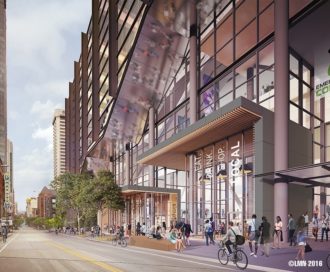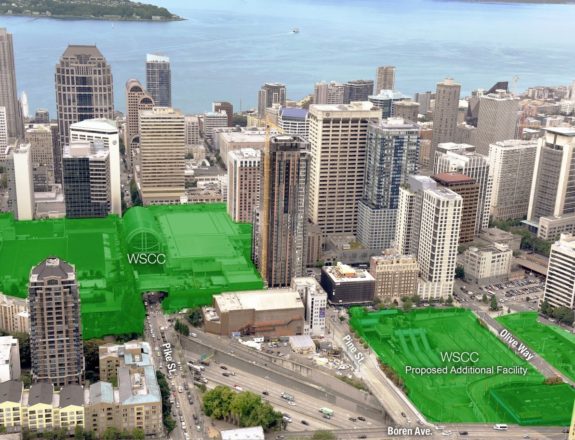
Much of the talk about public benefits from the planned Washington State Convention Center expansion has been focused on the very exciting idea of building a lid over more of I-5 connecting downtown to Capitol Hill and First Hill.
The Lid I-5 campaign hopes to get the full cost of a technical feasibility study paid for as part of the Convention Center project. That study is the first step to forming a plan that is ready to seek the kind of major grant funding the lid will need.
A lid study is a fantastic investment in a longer-term improvement for the Convention Center area, but the area is also in dire need to improvements today. That’s why complete and safe biking and walking connections should also be included in the public benefits, since these connections can and should be built as soon as possible.
“If we raise our voices, we could see key bike connections — including protected bike lanes along the Pike/Pine corridor and 8th Ave. — come online,” Cascade Bicycle Club wrote in a recent action alert.
The Pike-Pine corridor is one of the most-needed bike routes in the whole city. As the flattest and most direct way between downtown, the Convention Center and Capitol Hill, Pike and Pine are already very popular streets for biking. But people biking are forced to mix with general traffic or ride on the crowded sidewalks, neither of which are good options. Pine headed west (downhill) is not great, but Pike headed east (uphill) is genuinely terrifying.

The Convention Center also serves as a major crossroads for planned bike routes on 7th and/or 8th Avenues, connecting to South Lake Union and beyond. Building complete connections on Pike/Pine and 7th/8th would create a network of protected bike lanes that would make navigating downtown safe and comfortable for the many, many people who have no desire to bike in busy mixed traffic.
Cascade Bicycle Club has created a handy form you can use to send an email of support for the bike connections. Here’s their sample text:
To:
Beverly Barnett, Seattle Department of Transportation
Michael Jenkins, Seattle Design Commission
Bryan Stevens, Seattle Department of Construction and InspectionsI am writing to express my support for funding safe bicycle connections through the Washington State Convention Center expansion public benefits package.
Biking to, from and within the Center City is not currently safe. The City of Seattle has an incredible opportunity to improve transportation for people biking — and to alleviate car congestion — by building out a safe network of protected bike lanes as outlined in the Bicycle Master Plan.
I would like to express specific support for two key bike projects that are directly connected to the WSCC expansion:
1. The Pike/Pine corridor is the most direct way to connect Capitol Hill (a popular neighborhood for bicycling) with the Center City. This is a vital East/West bicycle connection that will transform transportation options between these neighborhoods. In addition to serving residents, this corridor will also be vital to allowing visitors to the WSCC to safely explore adjacent neighborhoods by bike.
2. A protected bike lane on 8th Avenue will provide an important Northbound route connecting the Center City with South Lake Union neighborhoods, as well as the recently completed Westlake protected bike lane. It pairs with the forthcoming Southbound 7th Avenue bike lane, which is funded and nearly finalized in design.
I urge you to fund these two vital bicycle connections through the WSCC public benefits package. They will serve all people in Seattle, including those we will attract here with our new convention facilities.
Sincerely,








Comments
13 responses to “Convention Center expansion should help build major bike network crossroads”
I sometimes get lost in all of the Plans and provisos and packages, so forgive me if I’m being dumb here, but is the decision about how to spend the money in this “public benefits package” separate from the Center City Mobility Plan? Why not focus on making the CCMP good for cycling infrastructure, and then just use the public benefits package funds to implement the CCMP? What’s the point of advocating for specific bike lanes as part of this Convention Center expansion? (Or have we already decided to ignore the CCMP, because it will just be superseded by a different plan in a year or two?)
I guess I’m just confused. We already have plans, and we have plans to have more plans. Why not focus on implementing those plans if we have money to play with?
Well, we know Pike and/or Pine will have to be completed as part of the network, and we also know 8th is the most likely northbound couplet for the planned bike lane on 7th if they choose not to build it two-way. This is about implementation for projects near the convention center, not in lieu of the One Center City Plan (the new name for the Center City Mobility Plan, which superseded the Center City Bike Network Plan, which was planned in parallel with the Bicycle Master Plan. Ok, I see you point about all the plans…)
Implementing capital projects might upset someone. Coming up with more plans makes it look like we’re doing something AND upsets no one.
Ding! Ding! Ding!
I didn’t even realize there was any funding shortfall on building modern bike infrastructure through this area.
As far as I’m aware, we approved a ton of money for bike infra in Move Seattle. I just don’t see a whit of it being built, other than a bad parody of a greenway through the central district — and a dangerous, narrow, chock-full-of-blind-corners compromise path on Westlake.
(Not coincidentally, I’m on the train to PDX with my bike, so I can go riding for a few days.)
Has there ever been any discussion about a lane connecting the Convention Center to Int’l District via 4th and/or 5th? It would pass by City Hall and the Library w/ Amtrak and the stadiums.
Somebody must have dreamed that up in one of those plans, no?
4th already has a Northbound lane for half of the distance
Got you covered.
https://thenorthwesturbanist.com/2016/05/31/how-to-build-bike-lanes-on-4th-avenue/
Yup, Scott, that 4th Ave Protected bike lane would be grand. There is no safe way of getting from Int’l Dist to Belltown.
Getting from the the end of the Dearborn bike lane (Dearborn and 5th) to 2nd Ave is almost impossible to do w/out breaking the law or riding on the sidewalk. Try it some time.
The Jackson/4th/2nd/Streetcar jumble is not for the faint of heart. But it doesn’t appear that Int’l District gets any love in 2016-20, according to the Bike Masterplan http://www.seattle.gov/transportation/docs/2016BMPImpPlanFinal.pdf
Is there a process for getting these areas included in future construction? How does the bike-lane sausage get made in this town?
@Will R.: Almost all downtown bike projects were removed from short-term consideration in (IIRC) late 2015, because the council was worried about how to keep buses moving after they get moved out of the tunnel before their light-rail replacements came online. The city keeps promising an integrated downtown transportation plan (including critical bike routes), but has released more silly name changes than real proposals.
So why are those buses getting kicked out of the tunnel early? Because the Convention Center expansion requires the (permanent) closure of Convention Place Station, years before ST/Metro were planning to do that.
Nobody has ever been able to explain to me why a state government should own and operate a convention center, which looks a lot like a regular business that a private company could operate. A private company wouldn’t have the power to disrupt whatever city operations it wanted to build the thing. If any private company came in to King County with an offer to buy Convention Place Station, and the county, after consulting with the City of Seattle and ST, said, “Hey, sure, let’s do this ASAP, damn the consequences,” that would be a scandal. This should be a scandal, too.
@Al Diamond Unfortunately, as Matt Griffin, the developer for the WSCC project, made clear at the ONLY open house the WSCC has ever hosted about this project, the WSCC is a public facilities district, a special district that has bonding authority tied to lodging taxes, can condemn property using eminent domain, but apparently has no real oversight from any government. It is run by a board of appointees selected by the governor, county executive, and the mayor of Seattle, but most of the current board members have been on the board for over a decade.
So really, it is a private company, except that its main source of income is Seattle’s 7% lodging tax, without which it would be hopelessly bankrupt. The situation is pretty disgusting, especially when though there’s no money for projects this city actually needs (transportation, bike safety, affordable housing), but there’s $1.6 billion for a convention center expansion that the city would be better off without.
Tell your city council members to not approve the street and alley vacations this project is requesting. It’s maybe the only way to stop this juggernaut.
[…] Connecting the network: Seattle Bike Blog says that the convention center expansion project should help build a major bike network crossroads near the development area. […]
Al – your points are very well taken. It’s crazy how rules get bent when the city has an overweening priority. The convention center is puny for a city of Seattle’s size and ambition. All knees must bend to the primacy of the CC expansion.
That’s not irrational – conventions are big business and us bikers are 5% of the population. If you were mayor, what would you prioritize?
So it goes.
Besides, Seattle’s actually doing some really great things in bike infrastructure. Lots of crucial gaps remain, but ‘gaps’ indicate that great infrastructure exists in many places – and there’s still significant work to do.
It’s a bummer that South Downtown (Pioneer Square, Int’l Dist, SODO) doesn’t get the attention that North Downtown does (Belltown, SLU, Seattle Center). Our bike institutions (Cascade Bike Club, Seattle Bike Blog, etc) will never fight for Rainier Ave or 4th Ave or a southern extension of 2nd Ave the way they fight for Westlake or SLU improvements or the Ballard Gap.
That’s not irrational either – NSea has way more cyclists than SSea.
So it goes.
It’s not just cyclists — the convention center expansion throws a wrench into planning and operations of transit service to and through downtown, to, and transit commuters are a pretty big fraction of downtown commuters!
Lots of things are big business and not run by the state — many businesses provide some kind of public benefit through their operation, and the public benefits claimed for convention centers aren’t that different than those claimed by professional sports arenas. Now even cities that don’t publicly fund arenas usually bend infrastructure around them, but they always have the right to say, “No.” I think if a private investor made the same proposal the state did to Seattle and King County, they’d say, “No,” or really more like, “Try again in 7 years” and I think this would be the right decision. And I don’t think state ownership of the convention center changes this.
Conventions are not big business. Without the approximately $70 million in tax revenue the WSCC receives each year, the WSCC would be totally broke. In contrast, the WSCC brings in about $4 million each year by renting space to conventions and shows. Convention space is over-built in this country, meaning convention centers like the WSCC have to subsidize events or give big rent discounts in order to attract them. This expansion will only worsen that glut of available space while creating huge hassles for city residents in the process.